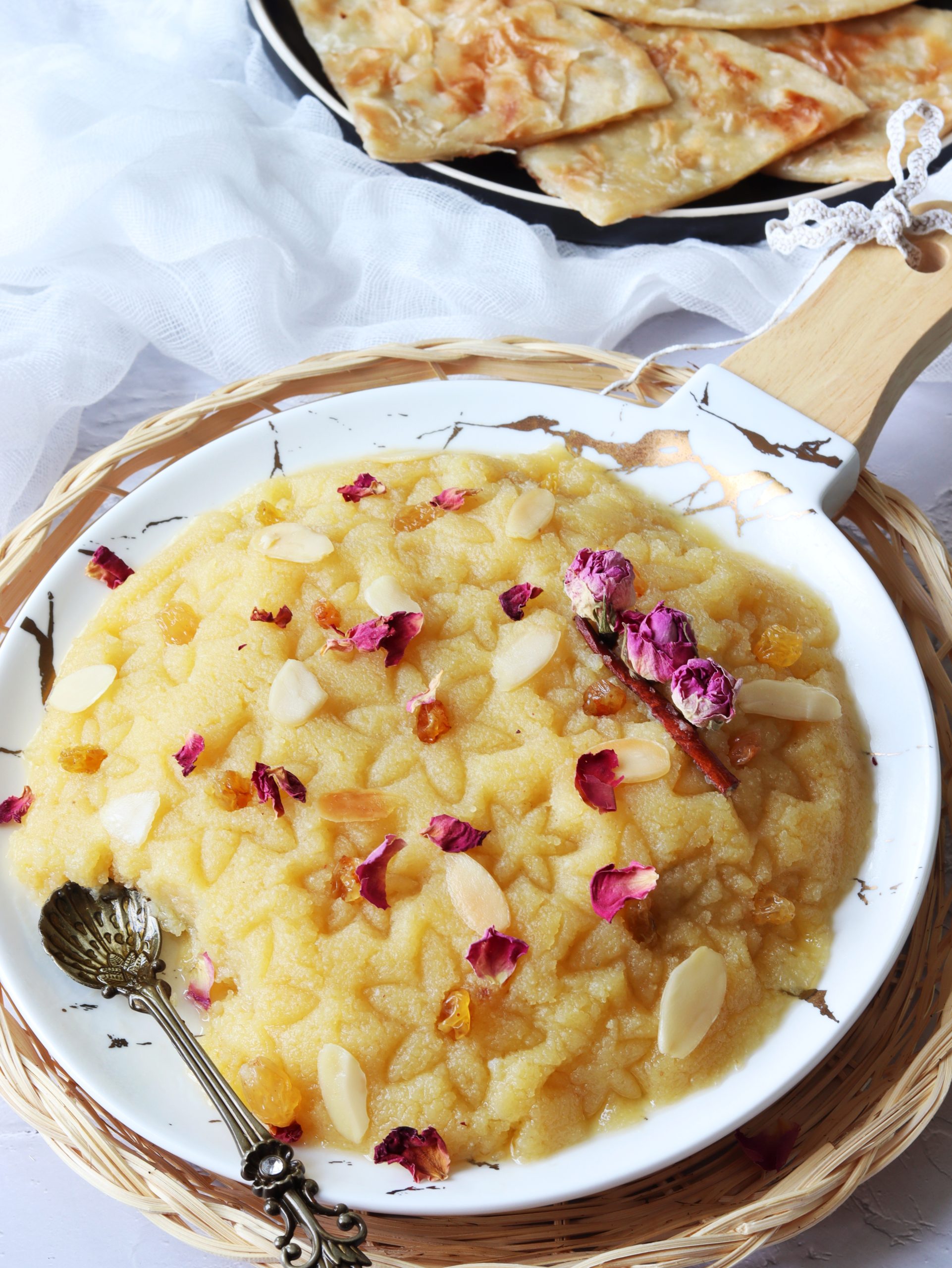Creamy Shujir (Semolina) Halwa

Creamy Shujir (Semolina) Halwa
Ingredients
Method
- Soak the semolina in milk for 1 hour.
- In a bowl, whisk the eggs and add sugar, ghee (reserving 1 tbsp for the end), and oil. Mix well.
- Pour in the semolina/milk mixture. Whisk together very well and add cinnamon sticks, cardamom pods, and rose water.
- Heat a wide, non-stick frying pan and pour in the mixture. Cook uncovered on low heat, stirring frequently. The mixture will start to thicken. Continuously scrape the bottom of the pan with a spatula as the halwa solidifies, taking care not to burn it. The key to achieving a soft, creamy halwa is to cook it slowly on low heat. This should take about 20 minutes.
- Add the milk powder and reserved ghee. Turn off the stove while the halwa is still runnier than you'd like, as it will continue to thicken as it cools.
- Transfer to a serving bowl/plate while still hot. Decorate as you wish, using almonds, raisins, and rose petals as garnish.
Creamy Shujir (Semolina) Halwa
This classic Bengali dessert has a special place in my heart. Wanna know the secret ingredient? It’s nostalgia. Each bite is a reminder of my childhood, my roots, and growing up surrounded by all the wonderful Bengali cooking of my mom and grandmother. Halwa can be served as dessert to eat after lunch or dinner, but my favorite thing to do is eat it with paratha for breakfast. Warm, creamy halwa paired with a hot, flaky paratha is a match made in heaven. One of my top favorite things to eat, EVER. There are dozens of different types of halwa, but this classic version is a popular one because it uses ingredients you probably already have at home.
What is Semolina?
Semolina is essentially a wheat which has undergone a process, resulting in a coarse, sand-like meal. In Bengali, it’s called shuji (sometimes spelled sooji or suji). It is also sometimes referred to as farina. It’s a popular ingredient in South Asia to make mostly desserts (sometimes savory dishes too), and believe it or not, baby food! In Bangladesh, semolina cooked with milk is a common first solid food for babies. You can find this in major supermarkets, and if not, you will definitely find it in a South Asian grocery.
And What is Halwa?
South Asian halwa (also halva/halvah/halua) is a dessert that comes in many forms, but is typically always flavored with ghee and sugar. Semolina, carrot, beet, and flour are some popular types. Semolina based halwas like this one usually start off by toasting the semolina in ghee, then adding sugar and other flavorings and basically cooking it down like a roux. The results are incredibly flavorful and pretty easy to pull off!
Why This Recipe?
The thing that sets this recipe apart from other halwas is its use of milk. Soaking the semolina in milk (vs. toasting the semolina) yields a super soft, creamy texture. No grainy, coarse halwa here! This recipe was passed down to me from my mom. When I asked her to teach me how to make it, she already had it all written down because so many people had already asked her for the recipe! It really is delicious and satisfying.
The Steps, in a Nutshell
The first thing you wanna do is soak the semolina in milk (in the refrigerator). Do this for at least 1 hour. More if you have time! Then, beat the eggs and whisk in the rest of the ingredients. Make sure it’s mixed super well.
What’s your best non-stick frying pan? Get it out, because that’s the one you’ll need here. Pour in the mixture, set the heat to low, and do a LOT of stirring and scraping the bottom of the pan with a spatula. The absolute, most crucial key to achieving a nice, soft halwa is to cook it low and slow. Resist the urge to turn up the heat to speed things up! As you stir, you’ll see that the mixture is starting to thicken and solidify. Keep stirring until it’s a smooth, runny paste.
Now add the milk powder and a bit of extra ghee for great flavor. Turn off the heat while it’s still runnier than you’d like, because it will continue to thicken as it cools. Transfer to your serving dish while it’s still hot. You can mold it to any shape you want and go nuts with the garnish/decorations! I personally love to use dried rose petals as a dessert garnish. Always looks so pretty and elegant!
What Do I Serve it With?
One word: paratha.
And Finally….
If you try this recipe, don’t forget to leave a star rating and comment below. And stop by my Instagram to say hello!